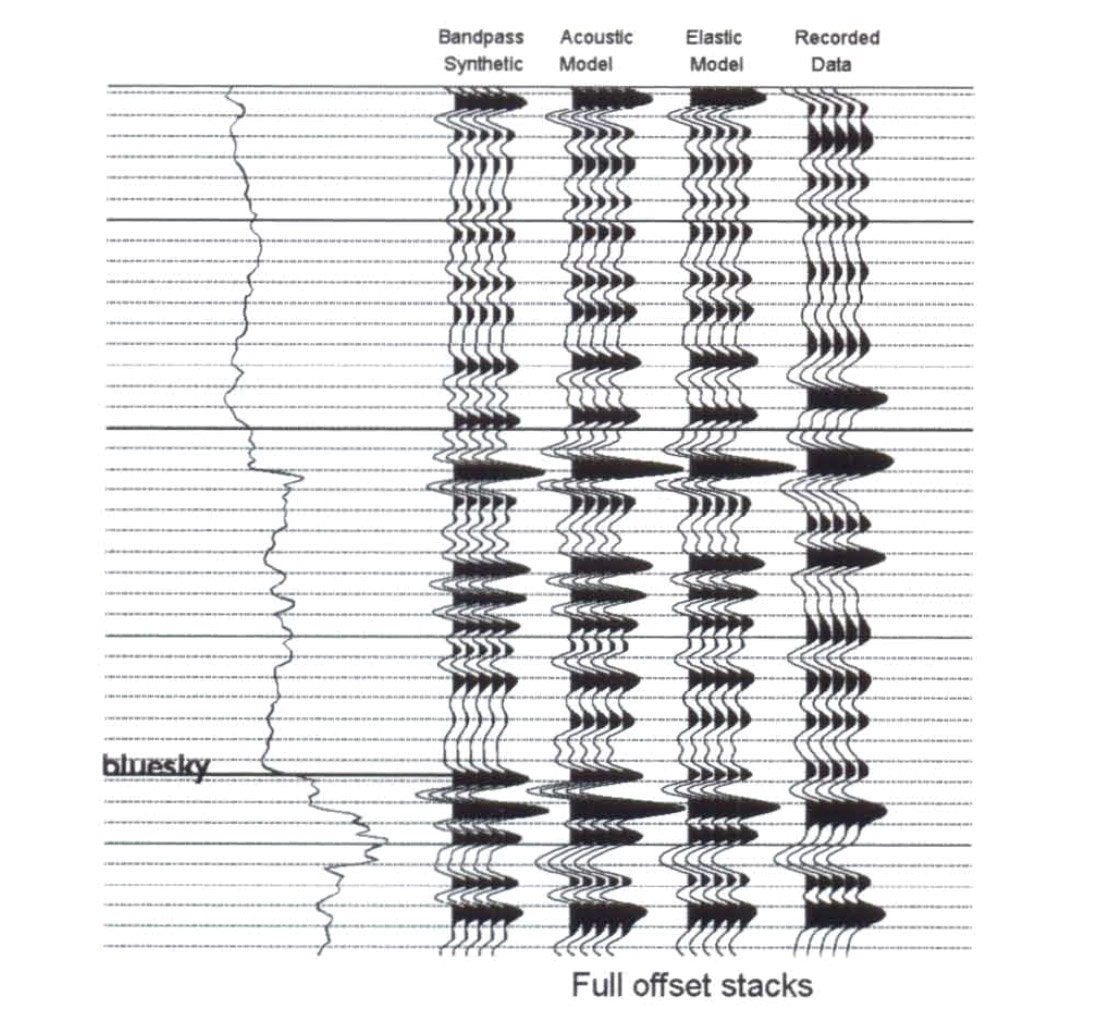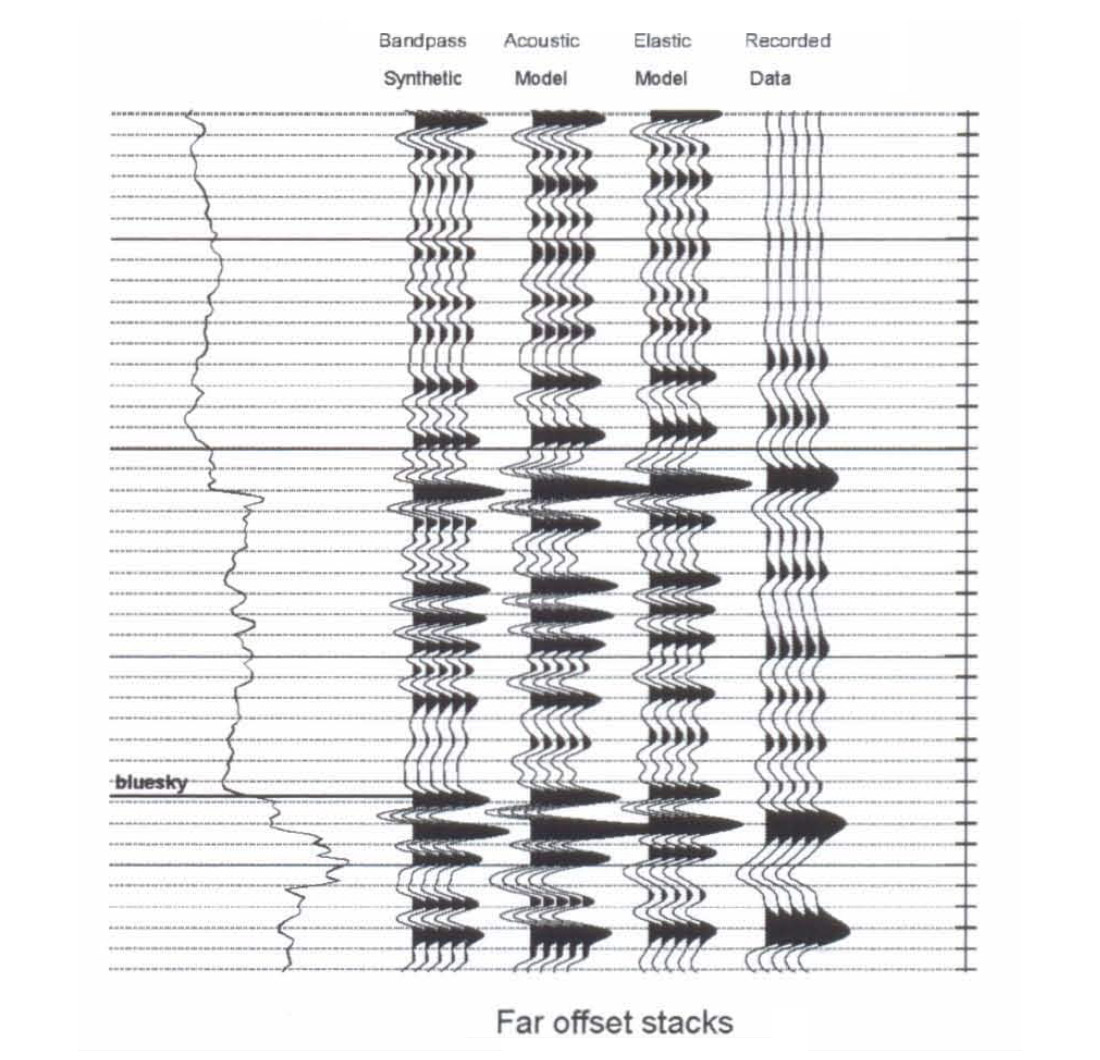Synthetic seismograms are a common tool in geophysical interpretation. They make use of the simple idea of correlating known subsurface information from a well with seismic data recorded on the surface. But sometimes a synthetic seismogram does not match a seismic section very well, and what should be a straight forward interpretation can turn into an adventure.
Recently I processed a seismic line for an interpreter who could not get the seismic character to fit with his synthetic seismogram. He had concluded that "something must be wrong with the processing because it doesn't tie my well", and so had contracted several shops in town to re-process this line.

This was a case of running quickly down the wrong path. It turns out the processing was fine (indeed the results from each contractor were very similar). The problem was the synthetic seismogram. We all had overlooked the assumptions lurking behind the routine construction of a synthetic seismogram, assumptions that mean that the synthetic is often representing something quite different than recorded seismic data.
How is a synthetic seismogram constructed?
"A one-dimensional synthetic seismogram is formed by simply convolving an embedded waveform with a reflectivity function . ...The embedded waveform is sometimes an assumed waveform (such as a Ricker wavelet)."
However it is known that seismic response varies with angle (offset). Since the stacked section is a summation of many different offsets, a two-dimensional synthetic seismogram which incorporates offset effects will be a more accurate representation of our seismic stack. That is, given a model of the earth (a sonic log, and hence reflectivities) we create a synthetic shot record by calculating what receivers at offsets would record. Then we can sum these offsets to mimic our cdp stack. (In fact, with a pre-stack synthetic seismogram lots of opportunities open up: we can sum just the near traces to mimic a near-offset stack, far to mimic far-offset stack, and so on. We can also do AYO analysis of the pre-stack synthetic to understand offset effects).
I construct pre-stack synthetic seismograms' two ways: via acoustic modelling or full-waveform elastic modelling. Each of these modelling algorithms make different simplifying assumptions; this table summarizes some of the assumptions and differences:
| Convolve Wavelet with Reflectivities | Acoustic Model | Elastic Model | Recorded Seismic Data |
|---|---|---|---|
| Construction of a Synthetic Seismogram: | |||
| vertical incidence; does not account for offsets | Zoeppritz's equations: offsets are accounted for in a simple fashion: | full wavefield is calculated as it moves thorough a stratigraphic earth | amplitudes are 'measured' at various offsets during an actual seismic survey |
| often a Ricker or Ormsby wavelet is used or a Bandpass filter | P-waves only (no S-wave conversions) | P-waves and S-waves | P-waves and S-waves |
| plane waves | spherical wavefront | spherical waves (point source) | |
| does not take into account does not take into account losses, attenuation, divergence, interference of multiples or of converted waves | accounts for transmission losses, attenuation, dispersion, tuning, multiple interference, converted wave events | transmission losses occur. as does attenuation, divergence, interference of multiples, and converted waves | |
| all offsets are 'stacked' (summed) to construct 'synthetic' | all offsets are 'stacked' (summed) to construct 'synthetic' | various offsets are 'stacked' (summed) to construct cdp stack | |
| (can also create near/mid/far stacks) | can also create near/mid/far stacks) | can also create near/mid/far stacks) | |
Example
Here is an example of synthetic seismograms constructed in these different ways at a gas well location. In this example, the Bluesky exhibits amplitude dimming with offset.


Note how these different synthetics correlate with the actual recorded data at the zone of interest.
The differences in the type of synthetic used to tie seismic data are more significant when one is interested in the far offsets.
It is interesting to note that the run times to generate the one-dimensional synthetic and the Acoustic pre-stack model are about the same (1 minute), but run time to generate the Elastic pre-stack model is on the order of 3 hours. I always run the Acoustic model early on to get a quick preview of offset effects, in some cases this is all that is needed. In other cases, the added information of the elastic model (multiples and converted waves in particular) is indispensable.
Conclusion
It is important to remember that a seismic stack incorporates offset information, so your synthetic should incorporate offset information as well. By constructing pre-stack synthetic models, we can get a more realistic synthetic, and a better understanding of seismic response. This insight can be a helpful guide for the processing and interpretation adventure.











Join the Conversation
Interested in starting, or contributing to a conversation about an article or issue of the RECORDER? Join our CSEG LinkedIn Group.
Share This Article